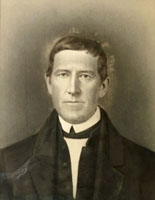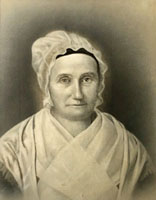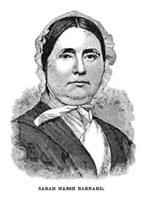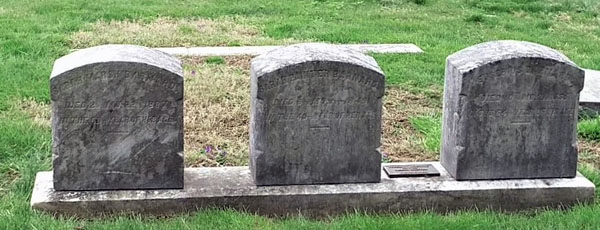
Eusebius and Sarah Barnard
 Eusebius, born July 13, 1802, was one of ten children of Richard and Sarah Barnard. He was raised near Marlborough village with many of his Barnard Family members in the immediate area owning farms from the vast amount of land his grandfather had accumulated. He attended the Friends school at Westtown and excelled in his studies. Family friend Gilbert Cope said about Eusebius "He was widely and favorably known as a strong abolitionist, earnestly advocated the cause of temperance reform, and being a man of great character and clearness of head his influence was felt in the community.” *
Eusebius, born July 13, 1802, was one of ten children of Richard and Sarah Barnard. He was raised near Marlborough village with many of his Barnard Family members in the immediate area owning farms from the vast amount of land his grandfather had accumulated. He attended the Friends school at Westtown and excelled in his studies. Family friend Gilbert Cope said about Eusebius "He was widely and favorably known as a strong abolitionist, earnestly advocated the cause of temperance reform, and being a man of great character and clearness of head his influence was felt in the community.” *
 Eusebius married Sarah Painter in 1829. Sarah, born December 19, 1804, was the daughter of Enos and Hannah Painter and grew up on the early homestead of her mother's Minshall family near the village of Providence, now in Delaware County which was also involved in the Underground Railroad. Sarah's brothers planted over 1,000 specimens of trees and shrubs and today this is Tyler Arboretum. Sarah's father had purchased the Barnard Station property years before and gave it to her sometime after she married Eusebius. Her father set it up so that when Sarah's sons became of proper age they would inherit the farm. We suspect one reason it was not put in Eusebius' name was because of his prominent participation in anti-slavery activities and concern the farm could be placed in jeopardy. Eusebius and Sarah had 8 children with 5 living into adulthood, 3 daughters and 2 sons.
Eusebius married Sarah Painter in 1829. Sarah, born December 19, 1804, was the daughter of Enos and Hannah Painter and grew up on the early homestead of her mother's Minshall family near the village of Providence, now in Delaware County which was also involved in the Underground Railroad. Sarah's brothers planted over 1,000 specimens of trees and shrubs and today this is Tyler Arboretum. Sarah's father had purchased the Barnard Station property years before and gave it to her sometime after she married Eusebius. Her father set it up so that when Sarah's sons became of proper age they would inherit the farm. We suspect one reason it was not put in Eusebius' name was because of his prominent participation in anti-slavery activities and concern the farm could be placed in jeopardy. Eusebius and Sarah had 8 children with 5 living into adulthood, 3 daughters and 2 sons.
The Barnards opened their home as a station on the Underground Railroad, often accepting freedom seekers traveling north from Wilmington, DE into Chester County. When freedom seekers arrived at the Barnard house they were given food, clothing and rest before moving on to the next safe house, often at 2 o’clock in the morning. Women and children may have slept on mattresses on the warm kitchen floor and men in the barn.
The Barnard children often helped. They also did their share of transporting freedom seekers if Eusebius was traveling for religious visits. One of the youngest conductors on the UGRR was their youngest son Enos who when just old enough to ride a horse led a group of 17 men on foot to his Uncle William Barnard’s house nearby Marlborough village. At times, if the coast was clear, the freedom seekers were hired for work on the farm. Pocopson had a large free African American community which likely helped in concealing the freedom seekers. However, even free African Americans weren’t always safe from possible kidnapping by slave hunters.Sadly, Sarah Painter Barnard died at age 45 leaving 5 children, the youngest 5 years old.
 Five years after the death of his first wife, Eusebius Barnard married Sarah Marsh in 1854. Sarah, born January 30, 1819, was the daughter of Gravner and Hannah Marsh, who for decades had been involved in Underground Railroad activities from their home in Caln Township. From a young age, Sarah guided freedom seekers from the family farm to other nearby safe houses. She occasionally loaded her dearborn so full of disguised “precious cargo” that she needed to ride in the front with her feet on the shafts. This attracted no attention, as she attended markets in Philadelphia and frequently had to ride this way when her wagon was packed with goods.
After she married Eusebius in 1854, the Barnards continued to aid freedom seekers at their farm in Pocopson Township. Eusebius and Sarah Marsh Barnard were active in Longwood Progressive Meeting, Eusebius being one of the founding members.
Five years after the death of his first wife, Eusebius Barnard married Sarah Marsh in 1854. Sarah, born January 30, 1819, was the daughter of Gravner and Hannah Marsh, who for decades had been involved in Underground Railroad activities from their home in Caln Township. From a young age, Sarah guided freedom seekers from the family farm to other nearby safe houses. She occasionally loaded her dearborn so full of disguised “precious cargo” that she needed to ride in the front with her feet on the shafts. This attracted no attention, as she attended markets in Philadelphia and frequently had to ride this way when her wagon was packed with goods.
After she married Eusebius in 1854, the Barnards continued to aid freedom seekers at their farm in Pocopson Township. Eusebius and Sarah Marsh Barnard were active in Longwood Progressive Meeting, Eusebius being one of the founding members.
Eusebius, Sarah Painter Barnard, and Sarah Marsh Barnard are buried in Longwood Cemetery across from the Meetinghouse (currently the Brandywine Valley Tourism Information Center).
* Historic Homes and Institutions and Genealogical and Personal Memoirs of Chester and Delaware Counties, Pennsylvania 1904 by Gilbert Cope for Chester County and Henry Graham Ashmead for Delaware County, page 513
